Te Muri Crossing coffee-and-croissants drop-in day
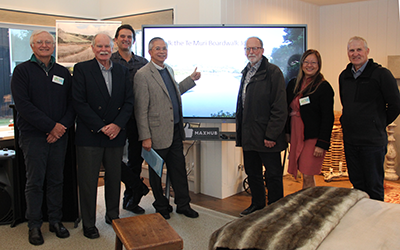
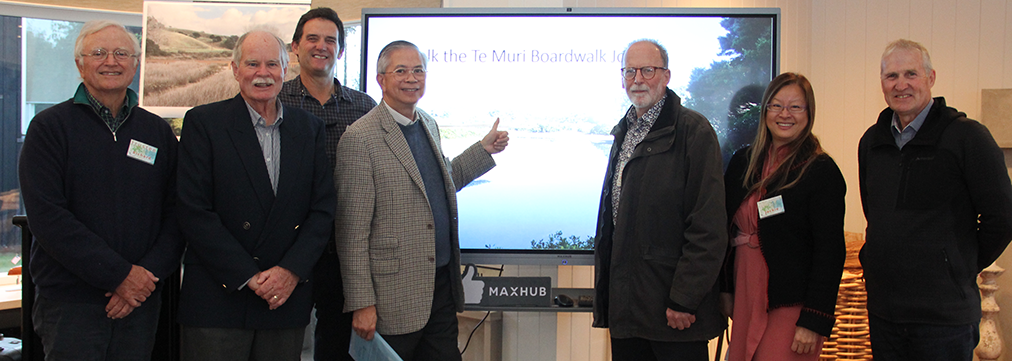
First Fundraiser Fronting with Design Detail: Briefly touched on by Professor Sir Peter Gluckman, the Resource Management Act that is cause of so much frustration for developers and community project leaders alike, is to be replaced, but that process is set to be as long-winded as the legislative juggernaut spawned by Sir Geoffrey Palmer itself. Good-naturedly contending with this environment is the day job of Mahurangi Coastal Trail trustee and coastal engineer Craig Davis, tallest by a forehead of the team working to inform and engage, and take money off, the high-tea attendees last Sunday. Craig’s presentation, tipped to begin at 11 am, on 3 July, will be the main feature of the coffee-and-croissants drop-in day. image Maree Owston-Doyle
Te Muri Crossing high tea 2022, will be on Mother’s Day. Mothers who were treated to Sunday’ high tea at Tu Ngutu Villa clearly enjoyed the afternoon, the star-studded cast of speakers, and the silent auction.
The silent auction, after initially having nothing not on offer at the November charity cocktail party, suddenly had so many new items to add, that the silent-auction organisers struggled to stay across the online bids. Consequently, it was necessary to keep the online auction running.
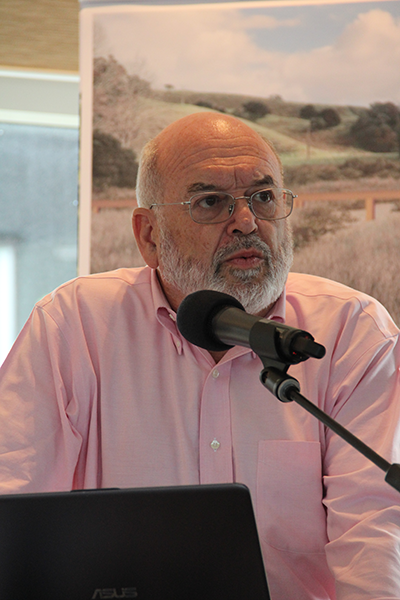
Gluckman’s Gauntlet: Distinguished Professor Sir Peter Gluckman deftly worked his talk summarising the epidemiological, public health, educational, and economic long-term impacts of covid-19, back to the Mahurangi Coastal Trail. His parting challenge to the trust was to ensure that young people used the coastal trail. photographer Maree Owston-Doyle
All the new offerings were thanks to team Eco-Comm Solution and friends, who, the following day, promptly put in writing their preparedness to support the next fundraiser. The co-star of the show, in fact, was the Eco-Comm Solution-supplied 75-inch Maxhub interactive flat panel. It was the perfect tool for coastal engineer and Mahurangi Coastal Trail trustee Craig Davis to walk the 60 guests through the boardwalk-and-footbridge Te Muri Crossing design process to date. Te Muri is fortunate indeed to have such a passionate, intelligent, entertaining and self-effacing coastal engineer working with the community to ensure that the Mahurangi Coastal Trail finally quells the 1950s instinct to develop private-light-vehicle access on Te Muri regional parkland.
A presentation by Mahurangi Coastal Trail trustee and coastal engineer Craig Davis will be main feature of the Saturday 3 July Te Muri Crossing all-day coffee-and-croissants Mahurangi West Hall drop-in. The nominal time slot for the presentation is 11 am–1 pm, but those who are unable to attend the main component will have other Mahurangi Coastal Trail trustees on hand to explain any aspects of the planned Te Muri crossing, and to note any suggestions or objections. Craig will also explain the costs of not just the civil engineering design involved, but that of the cultural, ecological, and landscape-and-visual impact assessments required to demonstrate that the built Te Muri Crossing will meet or surpass Resource Management Act and Auckland Unitary Plan requirements. The design mission’s mantra could be:
Unless you are walking across it, you won’t know it’s there—and when you are, it will feel like the most natural thing in the world.
Matthew Williams, who many locals will know from his long service as the resident Mahurangi Regional Park ranger, will be present in his current, recreation-and-education senior ranger role, for the duration of the drop-in. Matthew will answer questions about the operative regional parks management plan as it effects Te Muri, and the review process currently underway. The draft reviewed management plan is due for release sometime this year. Running concurrently with the management plan review process, however, is the Regional Land Transport Plan, decisions on the feedback on the draft of which are due late this month. On 1 May, the Mahurangi Magazine made a last-minute submission tightly focussing on the low-hanging fruit of public transport access for Wenderholm Regional Park, adding:
Public transport once served Wenderholm Regional Park, the first of Auckland’s wonderful coastal regional parks. That notwithstanding, over their 56-year history, Auckland Regional Parks have been highly private-vehicle-centric. This was never socially equitable, nor environmentally sustainable, but it is now patently incompatible with salvaging a survivable climate. Public transport access could well be achieved via volunteer-operated, fourth-tier targeted services. Popular regional parks, including the Wenderholm, struggle to deploy the many who volunteer.
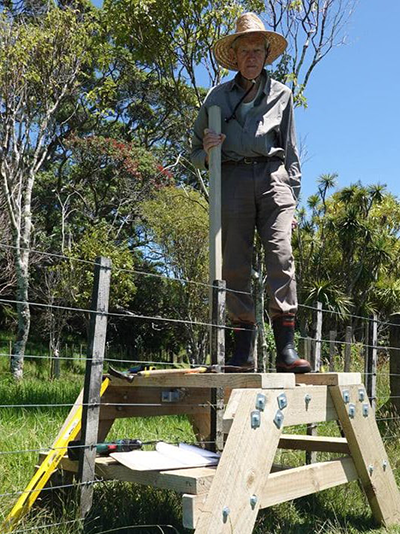
Te Muri Style: Necessitated by its highly archaeologically sensitive siting, this fruit of a 2020 Friends of Regional Parks working bee at Te Muri would have given the decades-earlier fencers pause, had they the meticulous care now taken to prevent damage to evidence of earlier settlement. Builder of the no-dig stile, also the society’s treasurer, might have been a regular Wenderholm volunteer these last decades, had that regional park not already had an embarrassment of support. image Friends of Regional Parks
The submission, published as a customisable pro forma, attracted 10 others, by the 2 May 11.59 pm deadline. Elsewhere, Friends of Regional Parks made a far more comprehensive submission, fearlessly tackling the private-light-vehicle-centric deficiency of Tāmaki Makaurau regional parks.
If it transpires that the Regional Land Transport Plan and the Auckland Regional Parks Management Plan talk to each other, those who revere Te Muri will see that the sense of splendid isolation that epitomises the bay preserved from private-light-vehicle incursion. Access will be by foot and by bicycle, and will be visited at least once by every young Aucklander, before they are eligible to hold a driver licence, even if it remains at its neurologically unsound minimum age of 16. This is but one means by which Distinguished Professor Sir Peter Gluckman’s high-tea challenge, to ensure the coastal trail is adequately used by young people, is met and surpassed.
Friends of Regional Parks, meantime, is a strong supporter of the Mahurangi Coastal Trail. Indeed, it supported Mahurangi Action in setting up the Mahurangi Coastal Trail Trust and is currently focusing its on-the-ground work at Te Muri. Its next Te Muri working bee is this Saturday. It is one of the rare opportunities to travel along the scenic ridge farm road, overlooking the yet-to-be-opened-to-the-public 383-hectares acquired in 2010. Ironically, for operational reasons, the journey is via private-light-vehicle. An Auckland Council 11-seater will depart Wenderholm at 10 am, from outside Couldrey House.
Back at the high tea, the most keenly bid-on silent-auction item was a 55-inch Maxhub interactive flat panel. Had such panel been available at the high tea, it would have been perfect, dedicated to displaying the bids, posted at the auction or online. It certainly would have ensured that the highest online bid wasn’t eclipsed by a lower one, as nearly happened last Sunday. When the sleep-deprived developer of the online system failed to ensure that the generous online bid for the last pristine copy of Jade River: A History of the Mahurangi hadn’t also been entered on the bidding sheets on the table, the prized item might have been wrongly awarded. Fortunately, the winning bidder was present at the high tea, spotted the lacuna, and smartly corrected it.
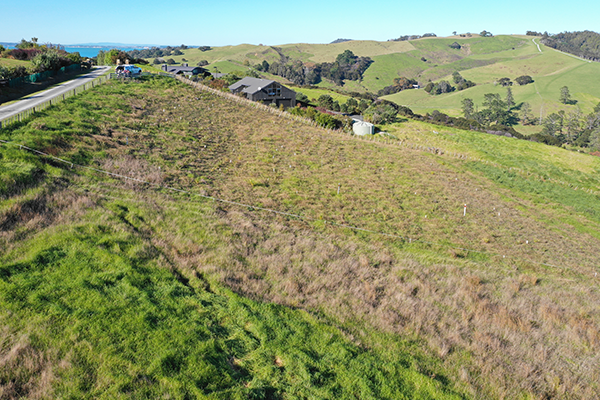
Spray, Plant and Walk Away: Potentially. The first-ever scientifically designed, randomised trial striving identifying what combination of plant size and spacing might produce a far more affordable, zero-maintenance regime for re-establishing indigenous vegetation. In the background is Te Muri Ridge, one of the many generous local silent-auction offerings snapped up, on 30 May. drone image Michael Bergin | Environmental Restoration
With the winner of the 55-inch interactive flat panel being a Mahurangi West resident, and although it was purchased for his workplace, high-tea organisers are hopeful that it may made available for the next fundraiser. That might be earlier in November than last year’s charity cocktail party, which was on the 21st. If this November’s cocktail party is on Sunday 1, Sunday 8, or even Sunday 15, it would be that much softer on pre-Christmas stress levels.
forparks boots on the ground Such is the support by Friends of Regional Parks for the Mahurangi Coastal Trail that this is the second year the organisation is holding working bees there, with the second of this year’s on Saturday 12 June, and the third, on 10 July—a low-tide planting day, making it more-readily supportable by the Mahurangi West community.
This is also Mahurangi Action’s second year of Te Muri work, but on the wider catchment, in the form of a harakeke-based ‘spray, plant and walk away trial’, aimed at identifying a zero-maintenance regime for re-establishing indigenous vegetation—restoring such cover is an essential tool in mitigating the sediment generation that is the scourge of not just the Mahurangi Harbour.
Disclosure The author of this article is the secretary of both Mahurangi Action Incorporated and the Mahurangi Coastal Trail Trust. The account published here, however, is that of the editorially independent, independently funded Mahurangi Magazine.
Order tickets to J Barry Ferguson Fund botanical art & New Zealand book exhibition now
Te Muri Crossing timeline
- 1965
- Wenderholm Regional Park acquired – first acquired by then new regional council
- 1973
- Coastal margin of Te Muri acquired – under the Public Works Act
- 1974
- Mahurangi Action established, as Friends of the Mahurangi Incorporated
- 1986
- Geotechnical investigation for planned road bridge across Te Muri Estuary
- 1987
- Suggestions for Te Muri access to citizens advisory group – by Mahurangi West and Pukapuka Residents and Ratepayers Association
- 1987
- Submission on draft management plan, including Mahurangi coastal trail as opposed to the proposed road from Ngārewa Drive, Mahurangi West
- 2010
- 383-hectare Te Muri hinterland acquired – resurrection of road access to beach
- 2010
- Auckland Regional Council subsumed by new, regional Auckland Council
- 2014
- Mahurangi Coastal Trail technical document for discussion – Mahurangi Action Incorporated
- 2015
- Phase-1 of Te Muri variation to regional parks management plan – 140 submitters
- 2015
- Mahurangi Coastal Trail Trust established by Mahurangi Action and Friends of Regional Parks
- 2016
- Phase-2 of Te Muri variation – further 383 submissions. All but a handful of 523 in total received oppose private-light-vehicle access to Te Muri Beach
- 2016
- No private-light-vehicle access to Te Muri Beach – resolution by Auckland Council
- 2019
- Memorandum of understanding between Auckland Council and Mahurangi Action to develop Te Muri Crossing and Mahurangi Coastal Trail
- 2020
- Davis Coastal Consultants retained by Mahurangi Coastal Trail Trust to design and seek resource consent for Te Muri Crossing
- 2020
- Phase-1 Regional Parks Management Plan Review submissions
- 2020
- With Ngāti Manuhiri, preferred route for Te Muri Crossing identified
- 2021
- First presentation of Te Muri Crossing design process – 30 May, tickets $80, free tickets offered
- 2021
- Coffee-and-croissants drop-in day at Mahurangi West Hall 3 July – free
- 2021
- Draft Regional Parks Management Plan due for release and call for submissions – target dates yet to be disclosed
